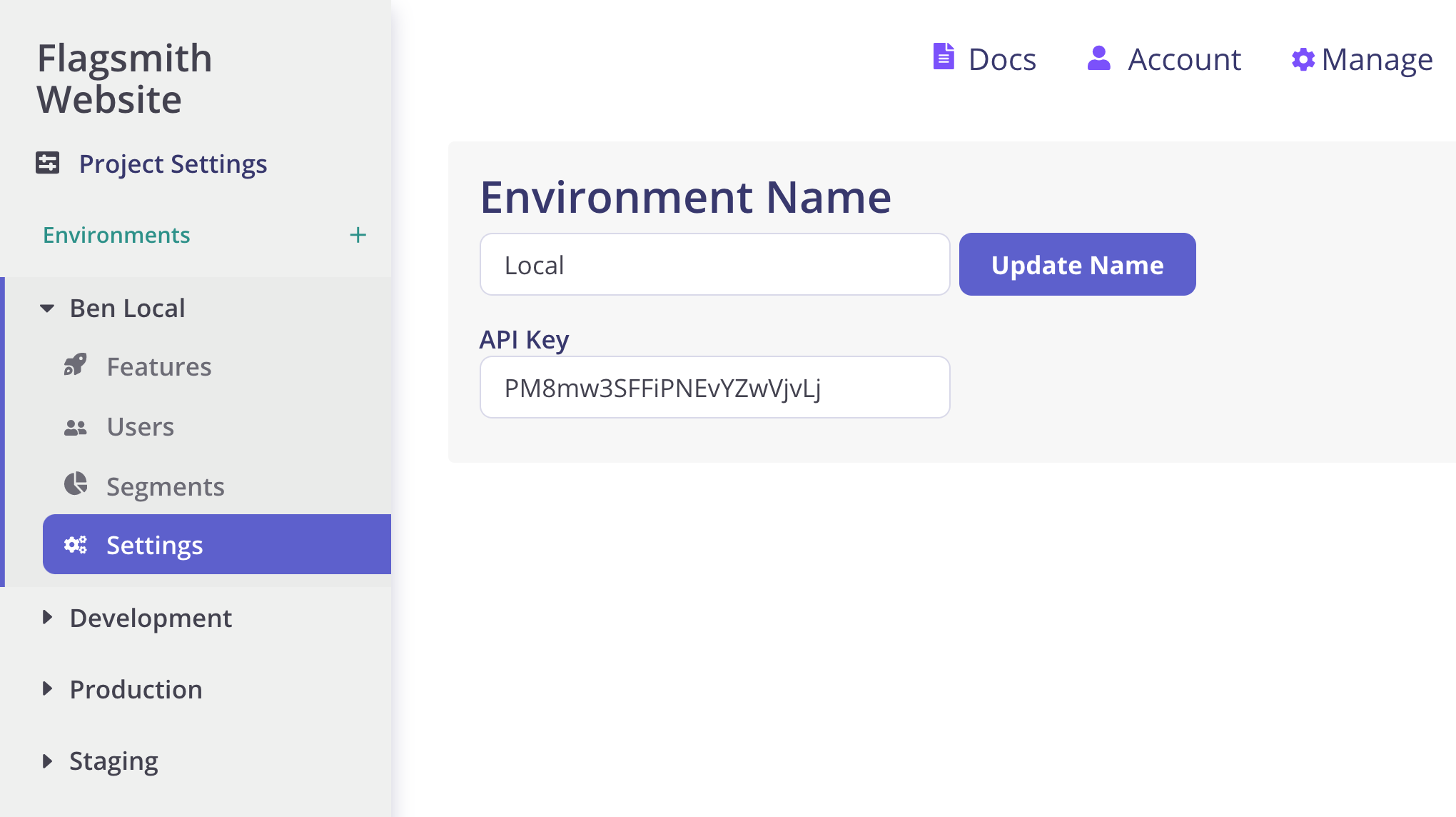Flagsmith .Net SDK
This SDK can be used for .NET Core, .NET Framework, Mono, Xamarin and Universal Windows Platform applications.
The source code for the client is available on Github.
Getting Started
The client library is available from NuGet and can be added to your project by many tools. You can find the package here https://www.nuget.org/packages/Flagsmith/
Basic Usage
The SDK is initialised against a single environment within a project on https://flagsmith.com, for example the Development or Production environment. You can find your environment key in the Environment settings page.

Usage
Retrieving feature flags for your project
Sign Up and create account at https://flagsmith.com/
In your application initialise the Flagsmith client once with your environment API key and API URL.
FlagsmithConfiguration configuration = new FlagsmithConfiguration()
{
ApiUrl = "https://api.flagsmith.com/api/v1/",
EnvironmentKey = "env-key-goes-here"
};
FlagsmithClient client = new FlagsmithClient(configuration);
You can then use the instance static variable on FlagsmithClient anywhere within your app.
To check if a feature flag exists and is enabled:
featureEnabled = (bool)FlagsmithClient.instance.HasFeatureFlag("my_test_feature").GetAwaiter().GetResult();
if (featureEnabled) {
// run the code to execute enabled feature
} else {
// run the code if feature switched off
}
To get a remote config feature value:
string myRemoteConfig = FlagsmithClient.instance.GetFeatureValue("my_test_feature").GetAwaiter().GetResult();
if (myRemoteConfig != null) {
// run the code to use remote config value
} else {
// run the code without remote config
}
Identifying Users
Identifying users allows you to target specific users from the Flagsmith dashboard.
To check if a feature exists and is enabled for a specific user:
featureEnabled = (bool)FlagsmithClient.instance.HasFeatureFlag("my_test_feature", "my_user_id").GetAwaiter().GetResult();
if (featureEnabled) {
// run the code to execute enabled feature for given user
} else {
// run the code when feature switched off
}
To get a remote config value for specific user:
string myRemoteConfig = FlagsmithClient.instance.GetFeatureValue("my_test_feature", "my_user_id").GetAwaiter().GetResult();
if (myRemoteConfig != null) {
// run the code to use remote config value
} else {
// run the code without remote config
}
To get user traits:
List<Trait> userTraits = FlagsmithClient.instance.GetTraits("my_user_id").GetAwaiter().GetResult();
if (userTraits != null && userTraits) {
// run the code to use user traits
} else {
// run the code without user traits
}
To get a specific user trait:
string userTrait = FlagsmithClient.instance.GetTrait("my_user_id", "my_user_trait").GetAwaiter().GetResult();
bool userTrait = FlagsmithClient.instance.GetTrait("my_user_id", "my_user_bool_trait").GetAwaiter().GetResult();
int userTrait = FlagsmithClient.instance.GetTrait("my_user_id", "my_user_number_trait").GetAwaiter().GetResult();
To get filtered user traits:
List<Trait> userTraits = await FlagsmithClient.instance.GetTrait("my_user_id", new List<string> { "specific_key", /* rest of elements */ });
if (userTraits != null) {
// run the code to use user traits
} else {
// run the code without user traits
}
To set or update a user trait:
Trait userTrait = await FlagsmithClient.instance.SetTrait("my_user_id", "my_user_trait", "blue");
Trait userTrait = await FlagsmithClient.instance.SetTrait("my_user_id", "my_user_number_trait", 4);
Trait userTrait = await FlagsmithClient.instance.SetTrait("my_user_id", "my_user_bool_trait", true);
To increment a numeric user trait:
Trait userTrait = await FlagsmithClient.instance.IncrementTrait("my_user_id", "my_user_number_trait", 1);
To retrieve a user identity (both features and traits):
Identity userIdentity = await FlagsmithClient.instance.GetUserIdentity("my_user_id");
if (userIdentity != null) {
// Run the code to use user identity i.e. userIdentity.flags or userIdentity.traits
}